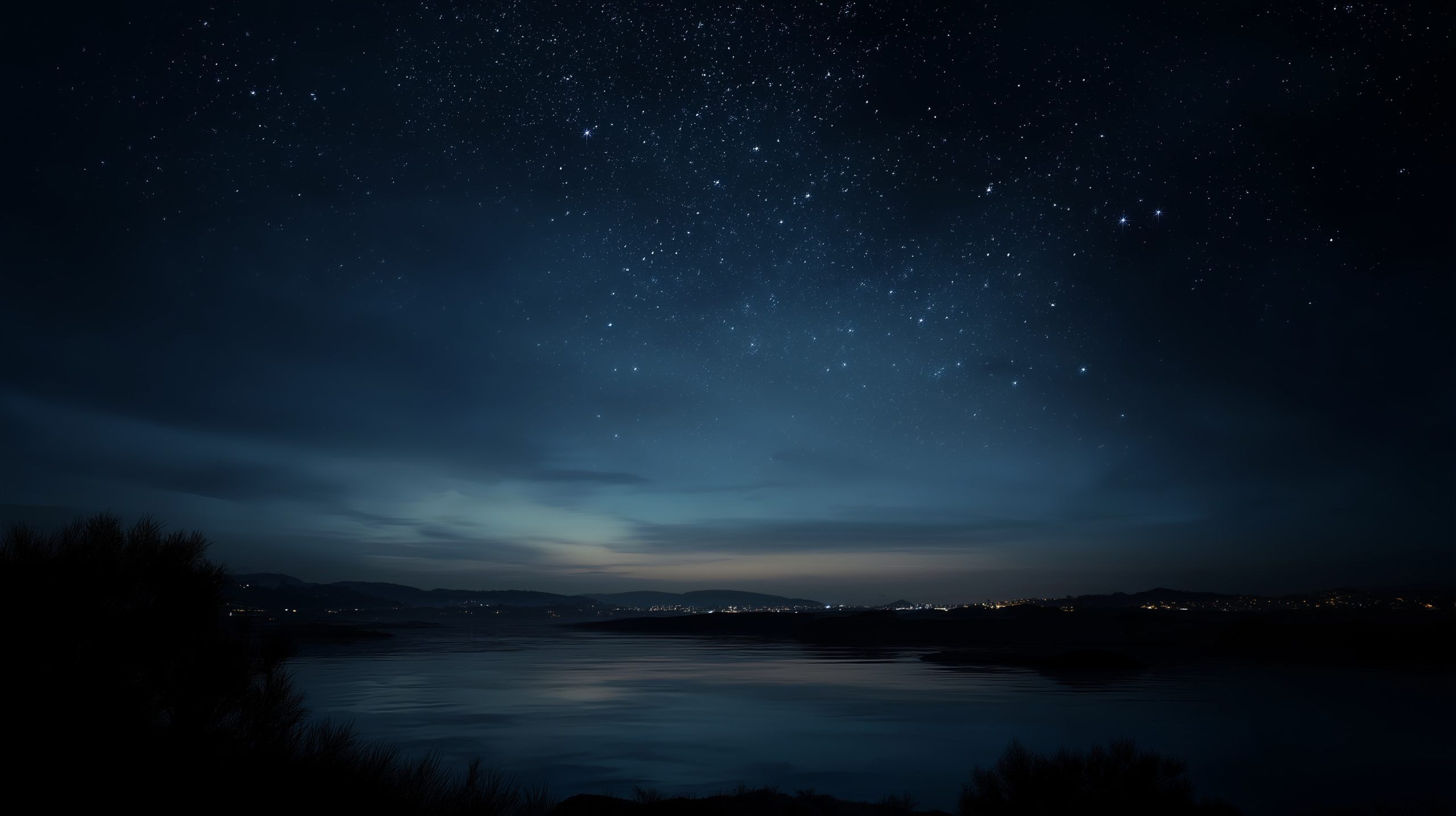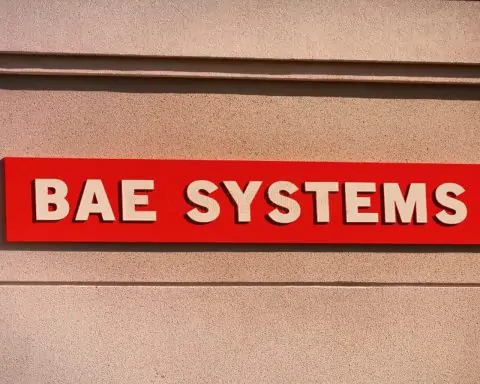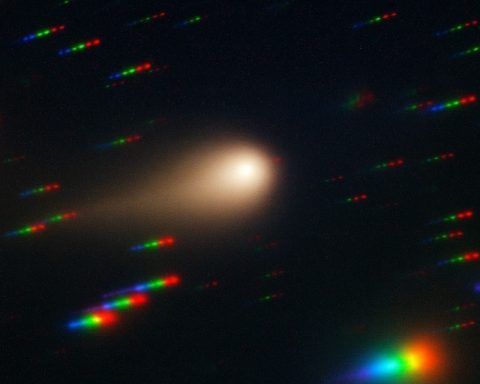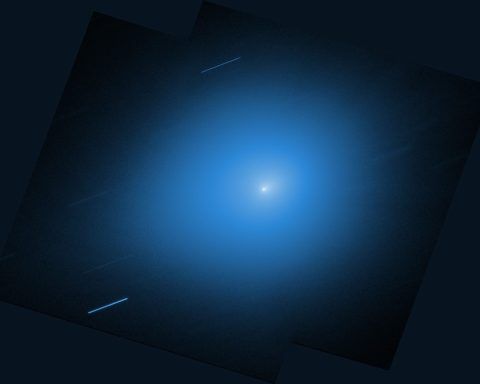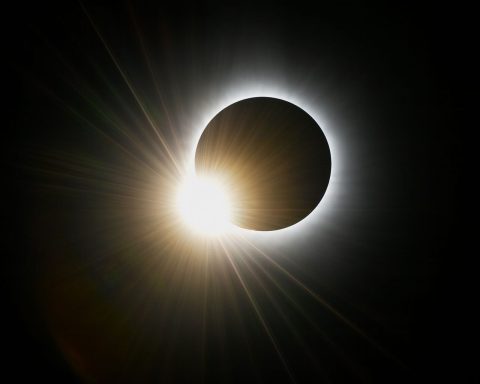- Aurora Watch: A minor geomagnetic storm is forecast for Oct. 8, with NOAA predicting G1-class auroras (and a chance for G2) as a pair of recent solar eruptions sideswipe Earth [1] [2]. Northern Lights could be visible at high latitudes and possibly farther south – weather permitting – though the glare of a near-full Harvest Moon may wash out faint auroras [3].
- Draconid Meteor Shower Peak: The annual Draconid meteor shower peaks the night of Oct. 8–9. Expect a modest show – around 10 meteors per hour under dark skies [4] – since moonlight will obstruct all but the brightest “shooting stars.” Uniquely, the Draconids are an evening meteor shower, with best viewing right after nightfall [5] [6].
- Harvest Supermoon & Planets: October’s Full Harvest Moon (a rare October supermoon) lit up the sky on Oct. 6–7, and remains a brilliant waning gibbous tonight [7]. This extra-bright moonlight is gorgeous but will diminish visibility of auroras and meteors. Meanwhile, Saturn – fresh off its late-September opposition – is shining near peak brightness in the evening, and Jupiter rises by late night.
- Solar Activity Update: The Sun is active but not explosive at the moment. A huge sunspot (AR4236) faces Earth with a complex beta-gamma magnetic field capable of M-class solar flares [8]. Several C-class flares and at least one M1.5 flare on Oct. 3 launched slow-moving coronal mass ejections (CMEs) toward Earth [9]. Those CMEs are arriving now, sparking the geomagnetic storm watch for Oct. 8 [10]. No major X-class flares have erupted in recent days, but forecasters give a ~40% chance of an M-class flare in the next day [11].
- SpaceX Launch & Rocket-Glare Clouds: A Falcon 9 rocket launch before dawn on Oct. 7 (carrying 28 new Starlink satellites) created an unexpected sky show: artificial noctilucent clouds. Observers in Virginia were stunned by eerie glowing wisps at sunrise – caused by rocket exhaust water vapor seeding icy clouds at the edge of space [12]. One commuter marveled, “They did not move or dissipate… I’d never seen anything like them!” [13].
- Satellite Reentries – Nightly Fireballs: Dozens of older satellites are steadily falling back to Earth. In fact, 1 to 2 Starlink satellites are re-entering every day on average, burning up as slow-moving fireballs [14] [15]. “There are currently one to two Starlink satellites falling back to Earth every day,” notes astrophysicist Jonathan McDowell, who tracks orbital debris [16]. With megaconstellations growing, he estimates we could soon see up to 5 reentries a day, barring mitigation efforts. Thankfully, these events are harmless – but if you catch a long-lasting, fragmenting fireball, you might just have seen space junk rather than a natural meteor!
Geomagnetic Storms & Aurora Alerts
A geomagnetic storm watch is in effect, as Earth encounters the debris of two solar eruptions from earlier this month. NOAA’s Space Weather Prediction Center forecasts minor G1-class geomagnetic storms on October 8, with a slight chance they intensify to moderate G2 level [17]. These disturbances are caused by a pair of coronal mass ejections (CMEs) – clouds of charged solar plasma – that launched from the Sun on Oct. 3–4 and are just now arriving at Earth [18]. As a result, skywatchers at high latitudes have an elevated chance to witness the aurora borealis (Northern Lights) on Oct. 8 and into Oct. 9.
However, timing and visibility are tricky. The glare of the 93%-illuminated moon (just two days past full) could outshine any faint auroral glow [19] [20]. If the solar storm is strong enough (G2 or higher), vivid aurora displays might still overcome the moonlight, at least on the northern horizon. NOAA notes that October is historically a prime time for auroras because around the equinox, Earth’s tilt favors more geomagnetic activity (the Russell–McPherron effect) [21]. In fact, late September to October often brings “surprise” auroral shows.
Forecasters emphasize there are no guarantees – geomagnetic storms can be fickle and require clear dark skies. If the predicted G1–G2 storm materializes, Northern Lights may be visible across far-northern Europe, Canada, and the northernmost USA. In the U.S., auroras could possibly be glimpsed low on the horizon as far south as the northern parts of states like Washington, Montana, North Dakota, Minnesota, Wisconsin, Michigan, and Maine [22]. Any aurora sightings in mid-latitudes will likely be subtle glows or flickers, given the moonlight and the relatively minor storm level.
To maximize your chances, head outside around local midnight on Oct. 8/9 to a dark location with an open northern view. Look for a diffuse greenish or reddish glow near the horizon. Keep expectations realistic – this is a minor solar storm. Even if auroras occur, the nearly full Harvest Moon’s light may drown out all but the brightest auroral pillars [23]. Spaceweather.com quipped that if the geomagnetic storm happens, “it might be invisible, with auroras overwhelmed by the glare of the Harvest Moon” [24]. In short, a beautiful lunar-lit night is guaranteed – and anything beyond that will be a bonus!
Draconid Meteor Shower Peaks Tonight
If you’re hoping to catch falling stars, tonight’s Draconid meteor shower is the main event. The Draconids are a minor meteor shower active each year from roughly October 6–10, and they peak on the evening of October 8 (into the early hours of Oct. 9) [25]. This shower is famous for being a bit of a wildcard: usually it produces only a handful of meteors per hour, but very occasionally it has surprised observers with brief meteor “storms” numbering in the hundreds or more [26]. Such outbursts are unpredictable – they happen only if Earth plows through an unusually dense clump of debris from the shower’s parent comet (21P/Giacobini–Zinner). No major outburst is forecast this year, so expect a normal Draconid display.
Under ideal dark skies with no moon, one might see up to ~10 meteors per hour at the Draconids’ peak [27] [28]. But 2025’s Draconid peak coincides with a bright moon: the waning gibbous Harvest Moon will be ~93% full on Oct. 8, pouring moonlight into the night. That means only the brighter meteors will be visible. “Alongside the waning gibbous moon, it may be hard to see” many Draconids at all [29], one astronomer noted. The moonlight essentially washes out faint shooting stars, much like urban light pollution would. So if you glance up and don’t catch any meteors, don’t despair – it’s largely the Moon’s fault.
What makes the Draconids still worth a look is their unique timing. Unlike most meteor showers that make you wait until midnight or pre-dawn for the best show, the Draconids are an early evening shower. They originate from the northern constellation Draco (the Dragon), which is highest in the sky in the evening hours in October. As People Magazine explains, “Unlike the majority of meteor showers that keep you waiting until after midnight, the Draconids arrive just after sunset, making it a rare twilight performance.” [30] Indeed, the radiant (apparent source point) near Draco’s head is highest at nightfall. This means the moment darkness falls on Oct. 8, the meteor activity can begin – no need to stay up until the wee hours.
For the best chance to see Draconid meteors, find a dark spot away from city lights as soon as the sky is fully dark on Oct. 8. Lie back and gaze toward the northwest sky, about halfway up from the horizon (around 40° up, near Draco and the Big Dipper) [31]. Give your eyes time to adjust. You might catch a few slow, streaking meteors emanating from the direction of Draco. Draconid meteors are often relatively slow-moving and can appear as long, lingering streaks. If you’re lucky, one might be bright enough to stand out against the moonlit sky. Remember, patience is key – with the low rates expected, minutes (even tens of minutes) could go by without any meteors. On the plus side, you won’t freeze waiting until 3 a.m.; you can hunt meteors in the evening hours (~7–11 p.m.) when it’s more comfortable for many.
This year’s Draconids are certainly a low-key affair, but they come with an element of suspense. As one astronomy writer put it, the Draconids’ unpredictability – quiet most years, spectacular on rare occasions – “keeps skywatchers coming back year after year.” [32] In 1933 and 1946, the Draconids famously produced storm-level displays of hundreds of meteors per hour. While nothing so dramatic is anticipated in 2025, the thrill of possibly catching a dragon’s surprise breath draws many out anyway. If clouds or moonlight thwart your Draconid viewing, don’t worry – another meteor shower is on the way. The Orionid meteor shower, spawned by Halley’s Comet, will peak on October 21 under much darker skies (the moon will be a thin crescent then). The Orionids typically offer around 15–20 meteors per hour at peak [33], and with the moon out of the way this year, it could be a far better show. So think of the Draconids as an appetizer; the main course of shooting stars comes in a couple of weeks.
Solar Activity Updates (Sunspots, Flares & CMEs)
The Sun itself has been busy this month, even if its effects on Earth (aside from auroras) have been moderate. We are currently near the peak of Solar Cycle 25, and the Sun’s face is freckled with sunspots. As of Oct. 8, the daily sunspot number is 109, indicating a robust level of activity [34]. The most noteworthy sunspot is Active Region 4236, a large dark spot cluster now facing Earth. AR4236 sports a “beta-gamma” magnetic field, meaning it has mixed magnetic polarities tangled together – a recipe for solar flares [35]. This region hasn’t unleashed any major flares yet, but it is harboring energy for stronger eruptions. NOAA gives about a 35–40% chance of an M-class flare (moderate intensity) and around 10% chance of a bigger X-class flare from the active regions in the next 24–48 hours [36] [37]. In other words, the Sun is crackling with small flares and could produce a moderate burst, but no severe solar storm is expected immediately.
Over the past few days, solar observatories have recorded numerous C-class flares (small “common” flares) flitting from various sunspots [38]. For instance, on Oct. 6 an active region (AR4233) produced a C5.1-class flare accompanied by a spectacular prominence eruption – a plume of plasma that blasted off the Sun’s limb [39]. Another sunspot popped off an M1.5-class flare on Oct. 3, which, importantly, launched a coronal mass ejection into space [40] [41]. It was that Oct. 3 CME, along with another from a filament eruption the next day, that set Earth up for the geomagnetic unrest we’re experiencing now (Oct. 7–8) [42]. The good news is that these CMEs were relatively slow and weak. They are causing G1–G2 disturbances at most – enough for some auroras, but no risk to power grids or satellites beyond the usual precautions. In fact, the geomagnetic storm index (Kp) has only reached unsettled levels (Kp 3–4) as of earlier on Oct. 8 [43], though it could tick upward if the thicker part of the plasma cloud arrives.
Space weather centers around the world, from NOAA to NASA to the Australian BOM, are monitoring the situation closely. The consensus forecast: continued low-to-moderate solar activity. The 3-day outlook calls for a possible uptick in geomagnetic activity Oct. 8 (as discussed) then a return to quieter conditions by Oct. 9 [44]. Unless a surprise flare erupts, we shouldn’t see anything stronger than a G2 storm. Meanwhile, sunspot AR4236 remains a region of interest. EarthSky reports that AR4236 is currently the “largest and most magnetically complex region” on the Earth-facing sun, though so far it has produced “no significant flaring” [45]. Skywatchers and radio operators will be keeping an eye on it – a sudden flare from that sunspot could cause a brief radio blackout or a new CME, but there is no way to predict exactly if or when that might happen.
Overall, the Sun is keeping us on our toes but hasn’t thrown any tantrums this week. We are enjoying a stream of gentle space weather: a high-speed solar wind here, a minor CME there. It’s a reminder that as we approach the solar maximum (expected around 2025–2026), these sorts of alerts and aurora chances will become more common. So even if tonight’s auroras or meteors don’t pan out, rest assured there will be plenty more celestial action in the months to come.
Moon, Planets & Other Celestial Events
Skywatchers this week are also basking in the glow of a brilliant Full Moon. On the night of Oct. 7 we experienced the Full “Harvest” Moon, which was extra special as a supermoon (the Moon is near perigee, its closest point to Earth) [46] [47]. This was the first full moon of autumn in the Northern Hemisphere and earned the “Harvest Moon” title for occurring closest to the fall equinox. It rose huge and golden on Oct. 6–7, delighting photographers around the world. In fact, 2025’s Harvest Moon was somewhat rare by falling in October (usually the Harvest Moon lands in September). It’s also the first of three supermoons slated for 2025 [48].
Even now on Oct. 8–9, the Moon remains bright and bold in the sky as a waning gibbous (about 92% illuminated). Moonrise in Warsaw (and similar mid-northern latitudes) on Oct. 8 is around 7:45 p.m. local time, and the Moon will arc across the sky all night. Its radiant silver light will beautifully illuminate the landscape – but as noted, it also creates a significant skyglow that makes faint stars and meteors hard to see. For astronomers, this is a week to enjoy the Moon itself (great for telescope views of lunar craters and maria) rather than deep-sky galaxy hunting. If you have a small telescope or even binoculars, take a look – the Moon’s brightness might surprise you, but with proper filters or just waiting until it’s lower on the horizon, you can see plenty of detail. Fun fact: Because it’s so close to Earth this month, the Moon appears about 14% larger and 30% brighter than a typical full moon [49] – one reason it’s casting such intense light.
Besides the Moon, the planets are putting on their own subtle show. Saturn is currently visible in the evening sky, high in the south after sunset (as seen from mid-northern latitudes). The ringed planet reached opposition (its closest approach to Earth for the year) in late September, so it’s still near maximum brightness and size in telescopes [50]. Around nightfall on Oct. 8, Saturn will be shining at about magnitude 0.5 in the constellation Aquarius. It’s a steady, pale yellow-white point of light. Interestingly, during the Harvest Moon festivities a couple nights ago, the almost-full Moon passed near Saturn – on Oct. 5, observers could see the Moon and Saturn only ~3° apart in the sky just after dusk [51]. If you missed it, don’t worry: the pair is separating now, but Saturn remains a gorgeous target a bit to the west of the Moon. Through even a modest telescope, Saturn’s iconic rings are easily visible. This is a great week to show friends or family Saturn’s rings, since bright moonlight won’t affect planet viewing much.
Jupiter is another treat – although it rises later at night. By around 10–11 p.m. local time, Jupiter will be rising in the east. It’s hard to miss: a brilliant beacon, outshining even the brightest stars (at magnitude –2.5 or so). Jupiter’s opposition is coming up around the end of December 2025, so the giant planet is approaching its best. In the coming weeks Jupiter will rise earlier and brighten further. For now, night owls or early risers (Jupiter stays up through dawn) can catch the king of planets high in the pre-dawn sky. Aim binoculars at it and you might spot the four Galilean moons lined up. And keep an eye on Venus in the morning – Venus has transitioned into the “Morning Star” after its inferior conjunction this past summer. By Oct. 9, Venus is rising about two hours before the Sun in the east. It’s extremely bright (mag –4) but you’ll need an unobstructed view toward the horizon to catch it in twilight. As autumn progresses, Venus will climb higher each morning. Mars, on the other hand, is out of view (it’s near the far side of the Sun).
No major eclipses or rare alignments occur on Oct. 8–9, but it’s worth noting we’re between eclipse events – a total solar eclipse happened back on Sept. 21, 2025 (visible in parts of Europe/Asia) [52], and the next eclipse will be a total lunar eclipse in March 2026. So this week is relatively eclipse-free. One odd phenomenon to watch for, though: with the Full Moon so bright, you might witness a moon halo or “moon dogs” if high thin clouds are around. These are icy halos (similar to sun halos) that can create a 22° ring around the Moon or mock-moon glows. Always a neat sight when the moonlight is strong.
Lastly, a charming autumn star to find is Fomalhaut, sometimes called the “Autumn Star.” It’s the lone bright star in the southern sky on autumn evenings (in the constellation Piscis Austrinus). With the moon up, Fomalhaut will be one of the only stars clearly visible in that area. It has a dusty debris disk and was even featured in sci-fi lore (“The Eye of Sauron” in astronomy circles). If you’re out meteor-watching early in the evening, see if you can spot Fomalhaut low in the south.
In summary, the Moon and planets are holding their own amid the solar and meteor excitement. Enjoy the supermoon’s glow, say hello to Saturn and Jupiter, and soak in the crisp October night. Even if nature’s fireworks (auroras and meteors) fizzle, the cosmic steady lights are always there.
Satellites & Spaceflight: Rocket Clouds and Falling Starlinks
Human activity in space is also making headlines alongside natural celestial events. In the early hours of Oct. 7, SpaceX launched a Falcon 9 rocket from Cape Canaveral, carrying 28 new Starlink internet satellites to orbit. The launch itself was routine for SpaceX (which is launching at a rapid cadence), but it produced an unusual skywatching treat: noctilucent clouds formed by the rocket’s exhaust plume [53]. Observers around dawn in parts of the U.S. East Coast reported faint, electric-blue cloud tendrils glowing in the sky. These were artificial noctilucent clouds – ice crystals seeded by water vapor in the Falcon 9’s exhaust, which then froze at the edge of space and caught high-altitude sunlight [54]. Jay Michaels of Springfield, VA witnessed the ghostly clouds just before sunrise on Oct. 7 and said, “I watched the clouds for more than an hour… They did not move or dissipate. I’d never seen anything like them!” [55]. Such rocket-induced noctilucent clouds have been noted before (even Space Shuttles caused them), but with SpaceX’s launch frequency, they are becoming a more common oddity [56]. Keep an eye out after predawn rocket launches – you might catch a similar eerie glow in the sky.
Those 28 new Starlink satellites join the ever-growing megaconstellation that now numbers over 8,000 satellites in orbit [57]. Shortly after launch, keen observers can sometimes spot a “Starlink train” – a line of bright dots – moving across the night sky. These are the fresh satellites in low orbit before they disperse. If you’re lucky, on Oct. 8–9 you might see one of these satellite chains shortly after sunset or before sunrise (check websites/apps for Starlink pass timings over your location). They look like a string of moving stars. SpaceX’s launches have made such sightings relatively common, though the company has tried to dim the satellites to reduce their impact on astronomy.
On the flip side, older satellites are coming down. We are in an era where satellite reentries – essentially human-made meteors – happen on a nightly basis. Experts report that currently one to two Starlink satellites reenter Earth’s atmosphere each day on average [58] [59]. These are satellites being intentionally deorbited at end-of-life or knocked out by increased atmospheric drag (exacerbated by the recent Solar max heating the upper atmosphere). When they reenter, they burn up and produce bright, slow fireballs that can be visible across large areas. In fact, on September 25, skywatchers in California were treated to a dramatic sight as a retired Starlink satellite streaked across the sky and disintegrated in plain view [60]. Videos showed a slow, fragmenting fireball – distinctly different from a fast meteor.
“There are currently one to two Starlink satellites falling back to Earth every day,” notes Jonathan McDowell, an astrophysicist who tracks satellite orbits, adding that with thousands more satellites to be launched, the pace of reentries will increase [61] [62]. In his estimation, once mega-constellations like Starlink and Amazon’s Kuiper are fully deployed, we could see around 5 satellite reentries per day on average [63]. Most of these go unnoticed (happening over oceans or unpopulated areas), and thankfully almost all the debris burns up completely. Still, it’s a new kind of nightly spectacle. If you see a slow-moving, long-lasting fireball that traverses a large portion of the sky, chances are you’ve witnessed space junk reentering, not a natural meteor. Meteor fireballs from space rocks tend to zip by in a few seconds, whereas reentering satellites can take tens of seconds or even minutes, sometimes shedding glowing fragments as they go [64].
Aside from satellites, the International Space Station (ISS) continues to make regular passes that are easily visible as a bright, steady-moving “star”. For example, in Europe the ISS will make a bright pass in the evening of Oct. 9 – a rewarding sight if clouds cooperate. You can check NASA’s Spot the Station service for flyover times. No major new spacecraft are scheduled to launch on Oct. 8–9, but rocket enthusiasts are looking ahead to upcoming missions (including NASA’s Lucy probe flyby of a Trojan asteroid mid-month and some eclipse observation flights later in October).
In the realm of human-made sky lights, one more note: Space debris and satellite flares. Some old-school satellites (like Iridium flares) used to produce dramatic glints, but most of those have been deorbited. Now, Starlink visorsats can sometimes glint as they rotate, but SpaceX has dimmed newer models. Still, you might catch an occasional brief flash from a tumbling piece of rocket body or defunct satellite – essentially an astronomical Easter egg.
Bottom line: Keep looking up! This week offers a little of everything – possible auroras dancing on the horizon, a handful of dragon-born meteors zipping across the sky, a glorious nearly-full moon and bright planets, and even the odd man-made spectacle from our ventures in space. Whether you’re an avid astronomer or a casual stargazer, the nights of October 8–9, 2025 have something in store. Bundle up, grab a warm drink, and enjoy the cosmic show – both natural and human-made – unfolding above. Clear skies!
Sources: NASA, NOAA Space Weather Prediction Center, SpaceWeather.com, EarthSky, People Magazine, Space.com, LiveScience [65] [66] [67] [68] [69] [70]
References
1. people.com, 2. earthsky.org, 3. www.spaceweather.com, 4. science.nasa.gov, 5. people.com, 6. people.com, 7. www.livescience.com, 8. www.spaceweather.com, 9. earthsky.org, 10. earthsky.org, 11. earthsky.org, 12. www.spaceweather.com, 13. www.spaceweather.com, 14. earthsky.org, 15. earthsky.org, 16. earthsky.org, 17. people.com, 18. earthsky.org, 19. www.spaceweather.com, 20. www.space.com, 21. people.com, 22. people.com, 23. www.spaceweather.com, 24. www.spaceweather.com, 25. people.com, 26. people.com, 27. science.nasa.gov, 28. www.space.com, 29. people.com, 30. people.com, 31. www.space.com, 32. people.com, 33. science.nasa.gov, 34. www.spaceweather.com, 35. www.spaceweather.com, 36. www.spaceweather.com, 37. earthsky.org, 38. earthsky.org, 39. earthsky.org, 40. www.sws.bom.gov.au, 41. earthsky.org, 42. earthsky.org, 43. earthsky.org, 44. earthsky.org, 45. earthsky.org, 46. science.nasa.gov, 47. www.livescience.com, 48. www.livescience.com, 49. science.nasa.gov, 50. www.livescience.com, 51. www.livescience.com, 52. www.timeanddate.com, 53. www.spaceweather.com, 54. www.spaceweather.com, 55. www.spaceweather.com, 56. www.spaceweather.com, 57. earthsky.org, 58. earthsky.org, 59. earthsky.org, 60. earthsky.org, 61. earthsky.org, 62. earthsky.org, 63. earthsky.org, 64. earthsky.org, 65. people.com, 66. earthsky.org, 67. people.com, 68. www.space.com, 69. www.spaceweather.com, 70. earthsky.org
